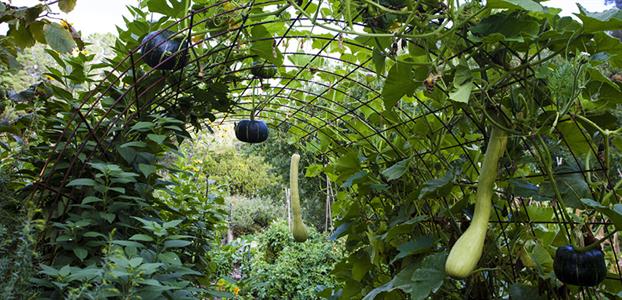One of the major concerns for many Preppers, especially after SHTF day has come to pass, is the continued ability to eat. Vast amounts of money are currently spent on dried goods that can be stored for an impressive length of time, but these menu items have nothing on the Food Forests. Food Forests are man-made, natural ecosystems, designed with sustenance and sustainability in mind. While it may seem inconceivable with just a passing glance, a little closer look will show that not only is such a system possible, but there are existing examples showing such man-made ecosystems still producing a surplus of goods, even thousands of years later, and without ever having to be farmed. In fact, one of the most common problems encountered by those who have grown their Food Forests to full maturity is the tendency to try to work … or farm the Food Forest too much. The Food Forests thrive exceedingly well without any interference from a man once they are fully matured. In short, free food with no farming. Any Prepper who has an acre or two … or more, can construct a food forest that will continue providing food for as long as it is allowed to grow. Naturally.
What Are the Food Forests
The Food Forests are a development of the originators of Permaculture and Permacultural Design, David Holmgren and Bill Mollison… at least according to most “experts” in the field. However, if truth be told, there are examples of Food Forests all over the world, and it would be more accurate to say that the Permaculture Institute merely reintroduced the concept to modern man. The development of the Food Forest involves a study of natural ecological systems or ecosystems, which are then copied, though with an added feature. Rather than throwing plant life in with seemingly random patterns as nature does, man-made ecosystems are introduced that utilize primarily plant life that produces fruits and vegetables. As these ecosystems then continue to grow with very little in the way of maintenance, over the course of time they grow into completely sustainable and long-lasting producers of goods.
When properly designed and implemented, the Food Forests will utilize the natural lay of the land, in addition to a series of ditches and mounds and a dam. The Food Forests begin with the introduction of nitrogen-fixing plants, primarily leguminous plants … lentils, beans, or other similar plant life. Once these plants have had the opportunity to take hold and grow and begin dying off, new plants will be added including any bushing plants and selected varieties of trees that will bear fruit. The selections made will have to be determined on plants that grow naturally in the local area, though the addition of some non-indigenous species of plant life is also common in many different food forests around the globe.
Ideally, an excess number of these bushing plants and trees will be planted so as to allow for the strongest to survive and take root as lasting crops. This process can also be enhanced through grafting, especially among different varieties of the same fruit. For example, if a “non-favorite” species of apple is indigenous but not ideally suited to the needs of the Prepper, the more desirable variety of apple can be grafted to the more sturdy and indigenous apple trees, allowing for substantially better growth.
Those plants that die off through the initial growth stages will allow for the creation of dead matter which will be naturally broken down to maintain growth and the overall sustainability of the Food Forest being created and an endless supply of nutrients for the soil. The moisture now flowing naturally through the soil will not only water the local ecosystem in its entirety but serve to accelerate the breakdown of organic matter from those plants that do ultimately die and return to the ground.
Related: 10 Trees Every Survivalist Should Know and Why
Building in Layers
The Food Forest should be an all-encompassing ecosystem with a consistent and natural pattern of growth, growing in the same way that natural ecosystems grow, meaning continual growth in “layers”. The primary focus should be on only a limited number of layers, though these layers will provide the Food Forest with everything that it needs to grow, without the Prepper having to become a botanical, biological or ecological expert.
The basic layers that need to be addressed and considered are varied in nature based on their growth and growth patterns. First among these, working from below the soil on up would be the root crops. These are crops such as sweet potatoes, peanuts and other similar crops that grow under the soil. The next layer is the ground cover layer which includes grass and other non-woody greens that will act as a ground covering, keeping in moisture, preventing erosion and other similar functions including the provision of nitrogen into the soil and a constant source of rotting vegetation to naturally (and continually) fertilize the soil. Above this layer are the herbs; smaller plants that do not grow into wood-bearing plants, meaning there is no bough (or trunk) and the branches are not wooden, but green plant life. After this layer comes the shrubs and bushes, including all manner of berries. After this layer will be the shorter trees; woody plants that generally produce fruits, but consisting of those that will never grow to extreme heights, such as apple, pecan or orange trees. After that will be the canopy layer, where the taller trees such will grow.
The Canopy Layer
This canopy will include trees like the avocado trees, some walnut trees, and other trees that reach up. In some locations, there will be trees that do extend beyond the canopy, such as coconuts, which will often grow taller than the tallest of other varieties of fruit-bearing trees and extend out beyond the actual forest canopy and which are generally considered to be an “Emergent” layer. After that, the last layer that needs to be considered is the Vertical layer consisting of vines and other climbing growth. This may include grapes, some beans such as string beans and other similar growth depending on the climate.
There should also be areas within the Food Forest that are maintained for the local wildlife. Bees can be introduced naturally if they will survive in the local climate. However, there also needs to be locations for naturally occurring insects, their predators, and even the local wildlife… including snakes, small game animals and any additions from the local wildlife populations who may wish to move in. Wildlife will eat a small portion of the food to be sure, though they will also in exchange, help to turn the soil, replenish nutrients through their waste or droppings and help to maintain a more sustainable and natural balance within the man-made ecosystem. A properly designed Food Forest can also serve to distract more predatory insects and birds, by confusing them with different varieties of flowers and fruits, effectively confusing them. It may sound outrageous, but it is also very true.
How Long Does it Take
Most Food Forests will not reach a full level of maturity and their maximum output for at least fifteen years. However, there is production each and every year, even from the very first year. Production will gradually increase and can be accelerated with the inclusion of partially grown trees in the early stages, though this should only be undertaken if there is already a substantial level of undergrowth to help maintain the nutritional levels of the soil on site.
A one-acre food forest should produce an adequate supply of fruits and vegetables to significantly reduce food costs within a few short years and should be capable of largely sustaining a small family after six to eight years. Full maturity, however, will vary depending on the individual species being planted in the Food Forest and how much the soil has to be naturally refined before planting can begin. Once the Food Forests have reached a sufficient level of maturity, however, they will largely take care of themselves, and if properly designed and implemented, even begin expanding into surrounding ecological systems providing even more beneficial returns for the Prepper for an untold number of generations into the future.
Related: How to Plant Fruit Trees
Old Growth and Ancient Food Forests
Australia (30 Years Old)
On what was originally one of the first “Testing Grounds” for Permaculture, a Food Forest was established and eventually, left strictly to its own devices without any human intervention whatsoever. It is both interesting and relevant to note how the Food Forest expanded on its own, and in locations where it met formerly unmolested ecosystems, integrated itself in the changeover from the man-made natural system into the existing natural system. It can be reasonably deduced from the expanded growth of this Food Forest that production has increased in proportion to the expansion of the man-made natural system in place. The almost seamless transition bordering the previously existing ecosystems indicate that this type of bio-dynamic growth will not put any of the local ecological systems at risk as some previous efforts at reforestation have done in the past. This particular Food Forest was largely built by Geoff Lawton who, while advancing in age, has a great deal of information available online and through the Permaculture Institute regarding Food Forests and learning how to properly establish and maintain them.
Vietnam (300+ Years Old)
The example in Vietnam is of particular interest as there are currently government funded studies surrounding the site in order to pursue large-scale efforts at recreating the technologies involved. According to the couple who is tending to the Food Forest, it has been in their family for some three hundred years. Again, it is likely safe to presume that there have been periods of time when this Food Forest has also gone unattended. It should also be noted that at the time of the report, the couple tending the Food Forest was in their eighties and unable to do very much, yet production of goods has continued at immense levels far too great for them and their families to consume in total. Their claim is that the property has been in their family and grown as it is for some twenty-eight generations. This example is also noteworthy because it introduces a great many medicinal and beneficial herbs and more complex and complicated layers of growth and undergrowth all providing for the benefit of the people there.
Southern Morocco (2000 Years Old)
Based on the existing growth and fauna, this ancient example of a Food Forest is estimated to go back roughly two thousand years in time. It is fairly safe to presume that during that time, there were extended periods when no human intervention was active in the maintenance or upkeep of this Food Forest. Even today, human activity within the site remains very limited and minimal while the production of fresh fruits and vegetables continues unabated, providing a wide range of wholesome and nutritious goods more than adequate to supply and sustain any nomadic travelers. The top is Date Palms with layers of pomegranates, guava, bananas, carob, mulberries, olives, grapes, figs, citrus and even tamarinds and other small crops. It should be noted that this is on the coastal region of Southern Morocco surrounded by large deserts.
Hazards of the Food Forests
In the early stages of growth and development, the Food Forests will have to be continually maintained and worked. Most of the work will come in naturally preparing and enriching the soil and planting. During the first six to ten years, it will also be necessary to go in once a month or so and top off the trees. There are many reasons for this, not the least of which is to reintroduce natural organic matter back into the soil in order to keep it healthy. However, this also has the added benefit, if properly done, of ensuring that a good portion of the produce grown within the Food Forest will always remain within relatively easy grasp as it will quite literally be “low-hanging fruit” ripe for the picking.
It should also be remembered that when the Food Forest does reach a sufficient level of maturity, excess “farming” or other undue interference from humans, will generally result in more detrimental results than benefits. Remember, a couple in their eighties in Vietnam are quite capable of maintaining and “farming” to the extent that any farming is necessary, a very large scale Food Forest that has been the subject of intense international research and study. Once the Food Forest reaches full maturity, leave it alone except for daily strolls to gather whatever it may be that one wishes to eat at the time.
Related: Trees That Can Be Tapped For Sap And Syrup
“We’re Here to Help”
Enter our good friends from the government… who are here to help… and to protect us from ourselves… even if they have to get violent to protect you. It is difficult to imagine that in a world where so many people are starving, the government would be anything less than supportive of programs like the Food Forests. Unfortunately, this is not always the case. Those Prepper Paradise locations where dams or other waterways have to be constructed or rerouted may find themselves both figuratively and literally under the gun.
The construction of natural dams or even natural water canals may lend the government to considering your land to be “wetlands” and thus in need of protection from you. Never mind that the entire system is completely and wholly natural. Never mind that a properly made Food Forest will often feed as many people as a much larger and more labor-intensive traditional farm. The government may indeed intrude and infringe on everything that has been built if they get the chance.
It is imperative to know the local laws and restrictions in addition to having an understanding of what the federal government is likely to pull out of their collective … legislation, regulations, statutes or anything else that they can think of to get what you have built… which brings us to the last major detriment of the Food Forests to consider.
Conclusion
There are currently somewhere around sixteen hundred species covered under the Endangered Species Act or ESA. So egregious is the ESA that there are numerous court cases challenging such laws as those claiming that even lands not directly occupied by an endangered species are critical to the survival of that species … and yes that is in the ESA. Current efforts are underway by government agents and agencies and activist groups around the nation, to criminalize the killing of any of these species… which seems to be a mere common sense on the surface… but the government knows no such common sense … or restraint as a rule.
The wrong insect splattered across your headlight or on your windshield may one day lead to criminal charges being filed, and all of your property stolen from you … all in the name of protecting you. The introduction of Food Forests will bring an untold number of creatures into the Prepper Paradise. While the average Prepper should be very proud indeed, of their newfound ability to feed a small army on very little land with even less work, they should be very careful about who they invite to visit and “see for themselves”.





















